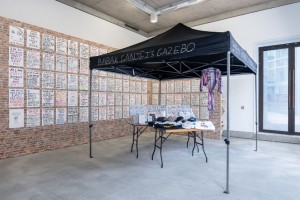“The Folklore is Seriously Spooky”
Adam Scovell: On Nettles

Adam Scovell’s latest novel, Nettles, tells the tale of a boy – relentlessly bullied at secondary school – who takes refuge in nearby marshland. As with his previous works, Nettles is punctuated and augmented by photographs; here, Scovell talks us through some key images…
Nettles follows a narrator revisiting his childhood home for the last time. His trip is marked by taking photos of certain locations that possess a personal significance, mostly due to things that happened to him at school twenty years or so earlier. The location is Wallasey on The Wirral, and the visits, at least, are more than a little autobiographical. The photos in question are all Polaroids and I was a little sad that we couldn’t publish them in colour in the book (they’re grainy scans on the page). So, here they are in colour.
School Lane
This is the first Polaroid the reader will encounter, though not the first photo (that’s a fragment of a photo of me in my school uniform the day before my first day of secondary school). This is the alleyway where the main childhood incident occurs involving the nettles of the book’s title. It’s actually quite a nice little path in summer as the vegetation is left to run wild, so lots of buddleia and insects. It still brings back God awful memories of heading to the field behind in the winter to be battered in “Games”. The mud from it used to reek for days afterwards, like it seeped into your skin. It was probably polluted. The field behind is now left for the plants and you can see how wild a place it is today, with the vegetation taller than most walkers.

The M53
The book’s narrator pays three visits with his Polaroid camera to the landscape under the M53. This is where he hid twenty years earlier when escaping the bullies of the school. It’s such an evocative location in hindsight, one that seemed perfectly everyday to me for a long while but gained significance as I realised how much work I liked as an adult had been made around similar places. In part, it’s like a northern version of J.G. Ballard’s Concrete Island, but the nearby marsh also strangely reminds of The Zone from Andrei Tarkovsky’s Stalker. Admittedly, the main constant of the place is the presence of burnt skeletal remains of scooters. It’s like some strange ritual from the north end; nab a Moped, skid it around under the road for a bit and then set fire to it. There has never not been the remains of one there.

Another photo by the motorway is actually gifted to the narrator’s father, and is less of the M53’s cavern underneath and more concerned with the marshland next to it. There are some lovely pylons around there and, because it’s such an overgrown place, they just look like part of the land. They could be natural. If you’re getting the train from Liverpool to Wallasey, you’re spoiled for views on either side. On the left you have the Ballardian concrete-scape, on the right you have the marsh with flooded train tracks, marsh and pylons. It’s amazing. It’s also the location roughly where the Labour MP Frank Field suggested building a container village to house “The Families” from the north end – a few families that caused a lot of crime and trouble in the area – when they were out of control in the early 2000s, though it was obviously rejected. I think he also wanted to put them in a concrete bunker under the M53 too, like they were radioactive material with a dangerous half-life.

Loggerheads
I wanted to include a painting in the book actually done in the schooldays, and this is the only one I ever kept. I think my last art teacher, the one that stopped me from being allowed to do art at A level, threw all our work away even before term had ended. This picture was actually done a few years later than the book claims but was still done under the same dictum by the teacher: “Draw somewhere important to you.” It’s meant to be Loggerheads in North Wales, and I remember it being one of the very few drawn in class that wasn’t just Anfield or Everton. But I was always happy with it, even if it was done with watercolour paints used incorrectly. I sadly lost it between moves around London a few years ago when I realised I had left it in the scanner of a previous (unfriendly) flatmate, so I’m glad it can be preserved in this book as I won’t be going back for it.

The Breck
The other main location of the book is The Breck in Wallasey, an eerie ex-sandstone quarry which is now a sort of half-arsed park. At its centre sits Grannies Rock which I’ve often described to people down here in London as a bastard punk cousin of Avebury’s stones. It’s like the black sheep of the standing stone family, just left and ignored, probably because it’s likely just one of the old crane pillars rather than a proper menhir. But it’s still amazing and the urban folklore surrounding it, which has passed between generations, is seriously spooky and played a huge role in the book. It feels perfectly natural that the narrator makes a pact with it to commit murder. The place also has an interesting link with the history of climbing, and a blue plaque is now there to celebrate the climber Alan Rouse. The Breck is a perfect plot of ghost-soil if ever there was one.

Adam Scovell
Catch Adam on 17 May at Blackwell’s Manchester in conversation with fellow author Paul Scraton. Nettles by Adam Scovell is available now, via Influx Press
All images © Adam Scovell





